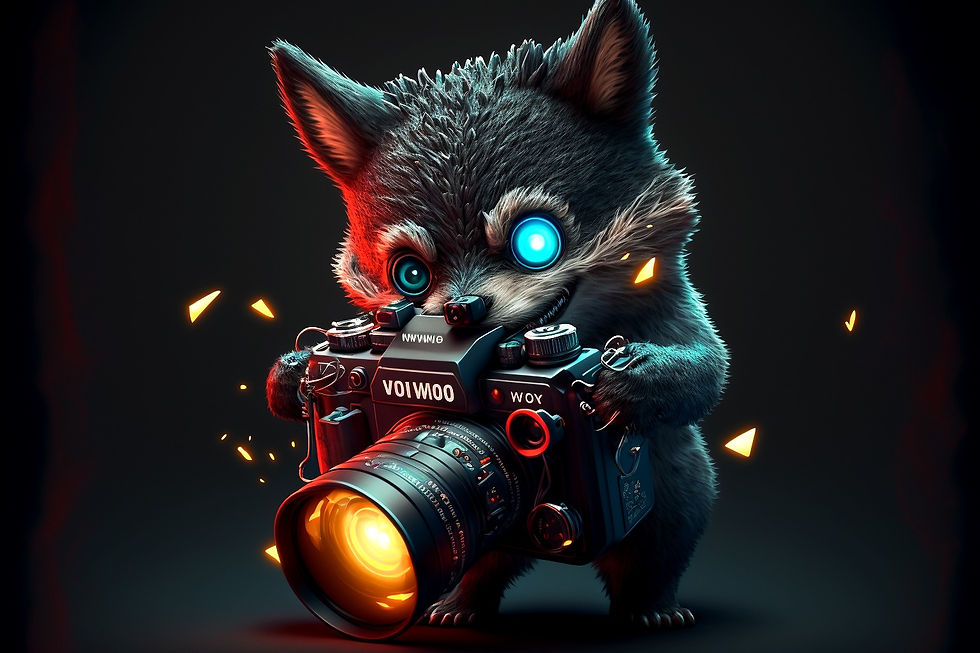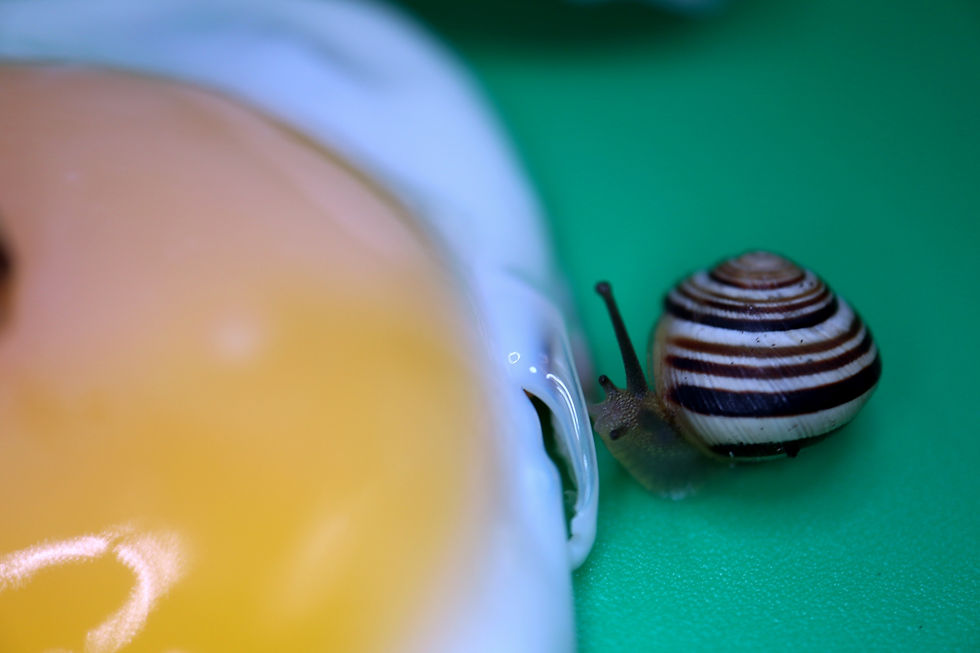Press Button To Blog - Horror Photography
- PressButtonToSquee
- Oct 29, 2023
- 6 min read
I just realized the word "horror" is going to lose all meaning by end of this by how many times I'll need to use it. I'm so sorry, but there's only so many ways to write "horror movies". Flay me alive why don't you.
So. Horror photography. A very niche genre in the art to say the least. Horror movies alone have an ebb and flow in popular culture based upon the success and fails of Hollywood. Sure, there's always an undercurrent of diehard fans keeping the direct-to-video underground horror flicks coming, but rarely are scary movies at the top of the box office.
My love for horror movies all started when I was just a child of five or six years old. My grandmother actually put on the Crater Lake Monster for me one evening, an absolutely dreadful 1977 monster flick about a blood thirsty Lapras free from its Pokeball (....if we're being technical it was a plesiosaur, which was a dinosaur). In hindsight, there are Goosebumps episodes that are scarier than this VHS drivel. But to someone whose still watching Sesame Street, that rubber headed beast was terrifying. There was blood and teeth and guns! Thomas the Tank Engine didn't need weapons to solve his problems. This was revelation for my tiny brain. What was this?
After that I was hooked. Not to get into the questionable details of my depressing childhood, but I didn't have great adult supervision. It took an additional few years to be able to actually be able to watch some more by choice, thanks to somewhat free reign when visiting Blockbuster and Rogers Video. Independantly though, it's kind of impossible for a kid to know about these things in the early 90's without overt introduction from somewhere else. There weren't copies of Fangoria in kindergarten you know.
But once I had the ability to rent what I wanted, believe me I watched some very inappropriate horror movies for a child my age. The first one that I recall that actually gave me nightmares was around 7 years old, and it was the Exorcist. Peering from underneath my blankey I was mesmerized by the gory scenes and the terrifying imagery portrayed on the TV. It was Regan crabwalking down the stairs is what did it for me. I spent most of the rest of the film with my eyes shut, listening to the demonic sounds she cried out, with my young imagination doing as much of the heavy lifting as what was put to screen. Until that point the few others I had seen were in the vein of monster movies and cheesy slashers. I was attracted to the VHS cases that showed claws and teeth, where the bad guys looked like they were going Trick or Treating if you squinted hard enough. Suddenly I came across a movie that was meant to make adults feel uneasy. A monumental event in cinema that helped harold in a new genre to the mass audience. The Exorcist made horror a genre to talk about. And it was the first (and one of the few) that would give me genuine chills.
As I grew older, I began to realize that there was something more to the macabre aesthetics of horror that fascinated me. There was of course the FEELING of excitment that horror fans chase. Like those additicted to rollarcoasters. You want to feel safe while being afraid. A jolt of adrenaline to the system that's proved to be the downfall to many. But more than that was everything that went into putting it togeather. The system behind creating the horror. There are the writers, who need to craft something suspenseful and terrifying, the fabricators of elaborate costumes, the manufacturers of the bloody practical effects, not to forget the crucial element of the the many scream queens behind all of the onscreen titalation. There was a craft behind it I admired as well.
The darker subject matter that's found in scary movies can put some people off. I get that. Not everyone can stomach entrails being splattered across the room. Even though I don't have the same reaction, I get that some peoples' brains react more vicerally than mine. Perhaps I'm just desensitized. Maybe I'm psychotic. I don't know. I'll leave that question for the doctors at my involuntary mental facility which was generously prescribed by my doctor. I'm kidding of course. There are no generous doctors.
But in all seriousness. Let's get back to talking about the boobies. The tits in scary movie titalation. I've always found that there is a close relationship between horror and eroticism. Made obvious by the copious amounts of nudity found in old school slasher flicks. The skin tingling taboo of it all has always been an easy sell to audiences. Both genres have the ability to explore taboo themes and push boundaries, often in ways that challenge our perceptions of what is acceptable. The popularity of horror movies and porn have been the cause of multiple societal shifts, as fans have rushed to defend them and morality laws have been altered to accept them. Ours likes and dislikes as a people are reflected in the things we choose to create and watch. Whether it's social commentary or sex work. Beyond that, taken to the extreme is teratophilia – the attraction to monsters and creatures – and how it relates to niche appreciation for horror and fetish photography.
One notable example of this kind of fetishism is found in the character of Pinhead from the Hellraiser franchise. Pinhead is both terrifying and alluring, his extreme appearance and BDSM-inspired outfit striking a balance of horror and eroticism. His whole gimmick had been built around the concept of a sadomasochistic otherworld. It's no surprise that Pinhead is a popular subject for artists and photographers who work in the dark and eerie realm of fetish imagery. The motif of he and his compatriots has been referenced in countless derivitive works and has influenced many fashion choices in underground scenes. Other examples are the nurses from Silent Hill, another franchise that's heavily influenced by sexual desire in multiple of its stories.
Suffice to say there's a great variety in the genre, ranging from the straight forward pinup girls pretending to be vampires like Elvira, to the elaborate scenes by the likes of Joshua Hoffine meant to look like screen shots from a movie. Horror shoots present their own unique challenges though. Sure, every photo needs a backdrop or a set. But finding the right location that sets the required tone is a challenge. Most people don't like the dangerous, dilapitated look in day to day life, as it tends to bring down the neighbourhood property values.
There's the specialty artists akin to those found on reality show Face Off. It's not simply enough to have worked at a Sephora, which would otherwise be beneficial for getting talent camera ready. No, horror makeup artists need to learn how to convey decayed, rotten flesh or a mutating alien virus burrowing under the skin. If the shoot is eleborate enough, you might need a fabricator to make props ranging from simple injuries to full body suits, or a graphic artist for post production Photoshop work to bring the fantasy to life where the real world fails. Much like cosplay, horror photography will often rely on intricate and outlandish outfits, unlike what most seemstresses are trained for. Buying some fabric off a roll and cutting it down isn't going to cut it. If any of you have ever been to a leather store, or more specifically a fetish shop, you'll know just how expensive that Pinhead style gear can get.
Then there's the models themselves. Often the type to prefer to remain aesthetically delightful, models usually aren't keen on actively making themselves look worse. Find someone who has spent years only showcasing their best sides from just the right angles, then tell them to contort their faces in fear and agony and watch as they learn about all of the double chins and crows feet that they didn't know they had. You need a particular type of person who is willing to lay contorted on the ground covered in simulated vicera and pretend like they're being mauled by a serial killer. That's not the type of work that typically leads to fashion shows and Instagram sponsorships.
Creating these kinds of images also requires a great deal of creativity and technical expertise. It's not enough to simply set up a camera and have your model pose in a creepy location. The lighting, composition, camera angles, and post-processing must all work together to create a compelling image that captures the essence of the horror genres.
The use of light, shadows, and color to create images that are both haunting and beautiful. To achieve that sense of horror that comes with something that is not quite right. It's not about being gratuitous or shocking for the sake of it, but rather capturing the darkness in a way that others can appreciate and relate to. It's about capturing the beauty in the horrifying and the artistic possibility in the grotesque.
Some people might dismiss horror as morbid, or even unhealthy, but for me, it's a healthy way to for people to express their fascination with the macabre and that which lives in the shadows. It allows us to push the boundaries of what is considered socially acceptable, explore taboo themes, and challenge our own perceptions of beauty and desire. And with so many talented and passionate artists and photographers working in the genre, there is a wealth of inspiration to be found for those who are willing to embrace the darkness and explore the unknown.



